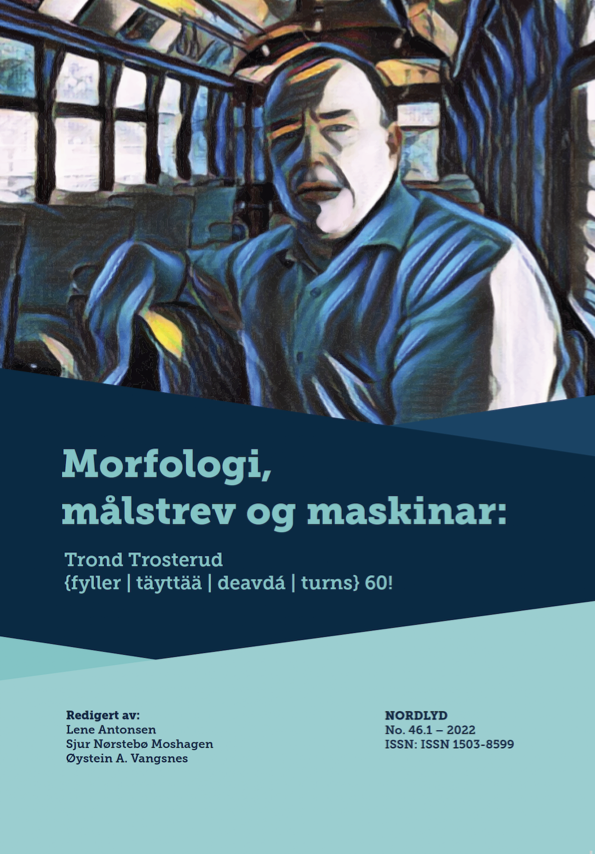Om kjønn og adjektiv
«Trond er så eksepsjonell/nydelig/skjønn/grønn»
DOI:
https://doi.org/10.7557/12.6386Keywords:
adjectives, statistics, gender, literatureAbstract
Do female and male writers use adjectives differently? This article is a survey of the potentially gendered use of adjectives in Norwegian novels. It is also a tribute to Trond Tosteruds's legendary article on grammatical gender. While our concern here is biological sex of authors and their use of adjectives, the man of the hour was concerned with rule-governed gender on nouns, albeit with a biological accent. Several readers — and listeners at MONS in 1999 — took note of the bold rule that said that oblong objects, not to mention protruding natural formations, are masculine, while natural phenomena such as pits and cavities are feminine (Trosterud 2001).
References
Abel, Georges. 1947. Manns- og kvinnespråk: en populær fremstilling, Oslo. https://www.nb.no/nbsok/nb/4a41b0e618c97415d4c32872da0a8670?lang=no#0
Amir, Zaini, Hazirah Abidin, Saadiyah Darus, and Kemboja Ismail. 2012. Gender differences in the language use of Malaysian teen bloggers. GEMA Online™ Journal of Language Studies 12(1): 105–124.
Baker, Paul. 2014. Using corpora to analyze gender. Bloomsbury, London, New York.
Bamman, David, Jacob Eisenstein, and Tyler Schnoebelen. 2014. Gender identity and lexical variation in social media. Journal of Sociolinguistics 18(2): 135–160. https://doi.org/10.1111/josl.12080
Barczewska, Shala og Andreasen, Agata. 2018. “Good or marvelous? Pretty, cute or lovely? Male and female adjective use in MICAS”. Suvremena Lingvistika 44(86):194-213. https://doi.org/10.22210/suvlin.2018.086.02.
Blatt, Ben. 2017. Nabokov’s Favorite Word is Mauve. New York: Simon & Schuster.
Bull, Tove. 2021. Kjønna språk og språkbruk før og no. Målbryting nr.12(2021): 1–24. https://doi.org/10.7557/17.5787.
Cameron, Deborah. 2008. The Myth of Mars and Venus. Oxford University Press.
Dyvik, Helge. 2018. https://norgramtall.w.uib.no/om-denne-bloggen/
Fishman, Pamela M. 1977. ‘Interactional Shitwork’. Heresies 2: 99–101.
Hartman, Maryann. 1976. A descriptive study of the language of men and women born in Maine around 1900 as it reflects the Lakoff hypotheses in “Language and Women’s Place”. Paper presented at the Conference on the Sociology of the Languages of American Women. New Mexico State University, Las Cruces, New Mexico, January 16–17. Available online at https://files.eric.ed.gov/fulltext/ED130316.pdf.
Jespersen, Otto. 1941. Sproget. Barnet, kvinden, slægten. Gyldendalske boghandel.
Johnsen, Lars G. Bagøien. 2022. Datasett https://doi.org/10.5281/zenodo.6425086
Kramer, Cheris. 1974. Women’s speech. Separate but unequal? Quarterly Journal of Speech 60(1): 14–24. https://doi.org/10.1080/00335637409383203
Lakoff , Robin T. 1975. Language and woman’s place. New York: Harper & Row.
Schmid, Hans-Jörg 2003. Do women and men really live in different cultures? Evidence from the BNC. In Corpus Linguistics by the Lune: A Festschrift for Geoffrey Leech edited by Andrew Wilson, Paul Rayson, and Tony McEnery, 185–221. Peter Lang.
Svendsen, Amalie Due. 2019. Lakoff and Women’s Language: A Critical Overview of the Empirical Evidence for Lakoff’s Thesis. Leviathan: Interdisciplinary Journal in English, 4, 1-11. https://doi.org/10.7146/lev.v0i4.112651
Tannen, Deborah. 1990. You just don’t understand: Women and men in conversation. New York: Morrow.
Trosterud, Trond. 2001. Genustilordning i norsk er regelstyrt. Norsk lingvistisk tidsskrift, 19: 29–58.
Uri, Helene. 2018. Hvem sa hva? Kvinner, menn og språk. Oslo: Gyldendal.
Downloads
Published
Issue
Section
License
Copyright (c) 2022 Ingebjørg Tonne, Helene Uri, Lars Johnsen

This work is licensed under a Creative Commons Attribution-NonCommercial 4.0 International License.





